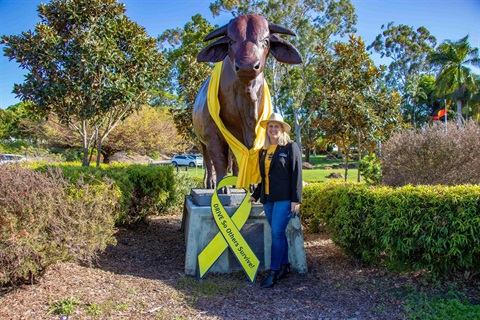Dr Janina McKay-Demeler of animal health company Dawbuts taking part in the AWI- funded trial.
AWI has funded trials of a relatively new method of conducting worm egg counts (WECs), called Mini-FLOTAC, which is ten times more sensitive than other existing methods. This will lead to ASBVs for WECs becoming available to ram breeders and buyers for many more rams than is presently the case, enabling easier and more accurate selection of better sheep.
FAST FACTS
- Selecting sheep for worm egg counts (WECs) can currently be a problem because a ram’s Australian Sheep Breeding Values (ASBVs) for WECs are sometimes not available, due to current methods of counting WECs having a low sensitivity and a high variability between sheep.
- A ram needs a significant worm burden before it can currently be provided with ASBVs for WECs. As ram breeders breed more resistant sheep, the difficulty in obtaining the required WEC levels increases.
- Animal health company Dawbuts has conducted an AWI-funded trial to introduce a relatively new egg count method (Mini-FLOTAC) which is ten times more sensitive than other existing methods, particularly the McMaster method which is currently the standard for conducting WECs for ASBVs.
- Sheep Genetics is using the data from three trial mobs to assess the implication of using this new Mini-FLOTAC method for WECs for ASBVs.
THE PROBLEM
Many sheep producers have expressed interest in selecting for WECs but have been frustrated because ASBVs for WECs are not available for many rams.
The main reason these ASBVs might not be available is that under current recommendations, a mob of sheep must have an average WEC of 300 eggs per gram (epg), with fewer than 10% of the flock having zero counts to make the cut for testing. This high cut-off value is necessary to account for the lack of sensitivity of the currently used egg counting method.
This presents several problems:
- Due to natural variation, a sheep mob with an average of 300 epg will have some sheep with very high counts, causing lost production, a high risk of sickness or even death.
- On many farms, especially those that have been breeding for low WECs, the mob average will less frequently rise to 300 epg.
- Seasonal conditions may mean that sheep are only exposed to a low worm challenge and cannot be assessed in dry years.
- Many ram breeders are in areas where worms are rarely expressed but have clients in high worm risk areas.
THE SOLUTION
The solution is a more sensitive worm egg count method. A recent project, funded by AWI, trialled a new method of conducting WECs for ASBVs using a more sensitive egg counting chamber, the Mini-FLOTAC device. The Mini-FLOTAC device can routinely read WECs at a LOQ (limit of quantification) of 5 epg, ten times more sensitive than current methods such as McMaster slides.
Dr Janina McKay-Demeler of Dawbuts laboratory outlined the new method.
“Faecal samples from individual sheep are mixed with saline and examined under the microscope, just as we would do in the traditional method. However, the Mini-FLOTAC slides are slightly larger, meaning that a bigger faecal sample can be used. They also have a circular rotating mechanism that moves the faecal debris away from the eggs, meaning the worm eggs are clearly visible,” she said.
“It is a simple but ingenious device that makes it easy to do routine worm egg counts with very high sensitivity yet still requires a similar amount of labour as the traditional methods. Several comparison studies have shown that in sheep with high WEC both methods display a very similar result but when it comes to low WECs, the Mini- FLOTAC method is a lot more accurate.”
The researchers then tested animals in tandem to see if the results from the new technique could be used in the same way as the traditional techniques to calculate ASBVs for WECs. Dr Andrew Swan of Sheep Genetics ran the results of three separate trial mobs of sheep, from farms in WA and NSW.
“The sheep were tested by both the traditional McMaster method and the Mini- FLOTAC,” explained Dr Swan. “We then went through the process of constructing ASBVs using both methods. The results are comparable in the higher epg areas but due to greater sensitivity a lot less negative WECs were obtained.”
NEXT STEPS
This is a promising result which will now lead to the important part of reconstructing the algorithm behind the ASBV calculation in Sheep Genetics, taking into account, firstly, sheep with lower WECs in order to decrease the current cut-off value of 300 epg and, secondly, the smaller categories of values obtained, now only in increments of 5 instead of 50.
Once a new algorithm has been established and successfully employed in the ASBV scheme, testing for WECs and selling rams with WEC ASBVs will become easier and the information more available for ram breeders and buyers.
This article appeared in the March 2020 edition of AWI’s Beyond the Bale magazine. Reproduction of the article is encouraged, however prior permission must be obtained from the Editor.







